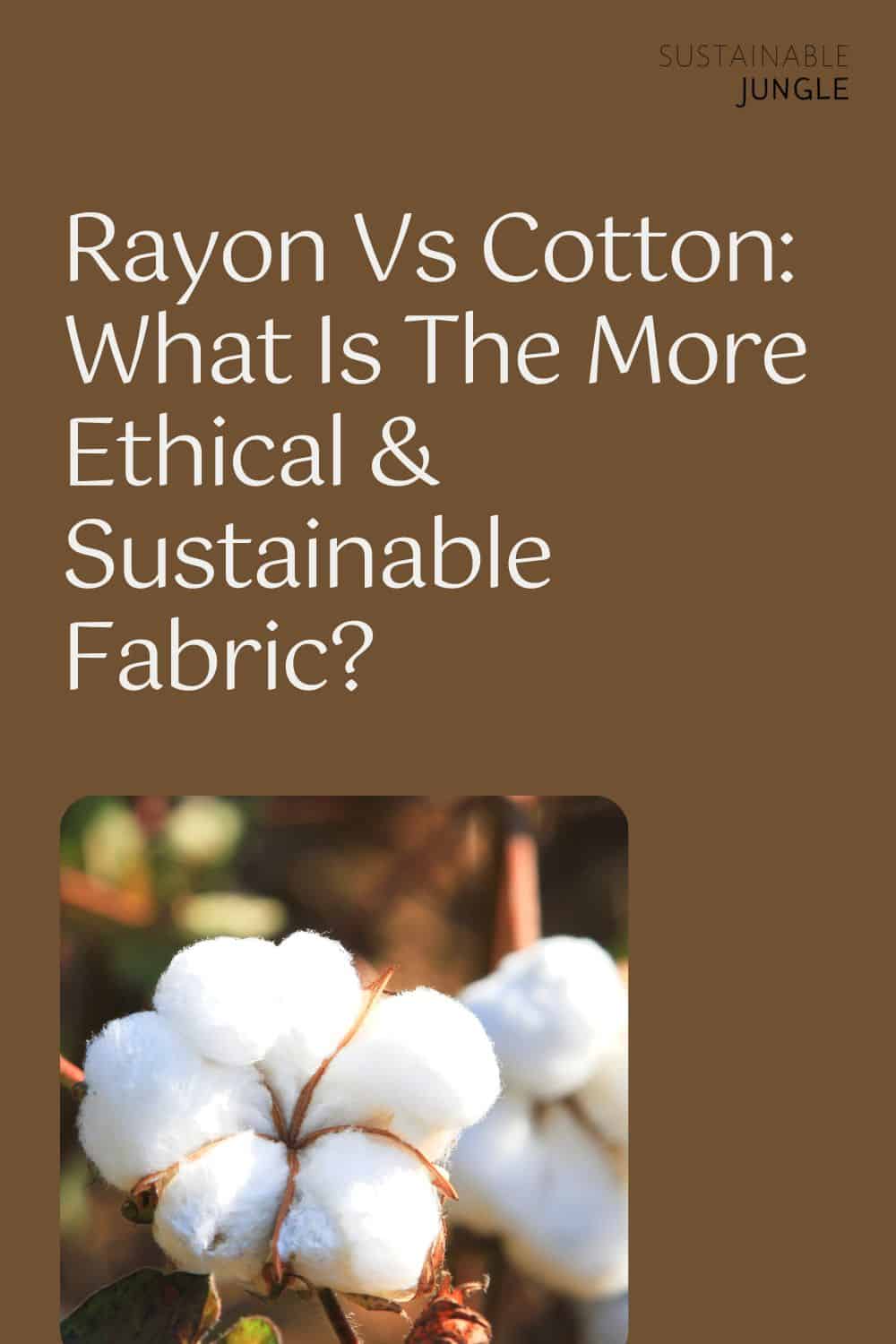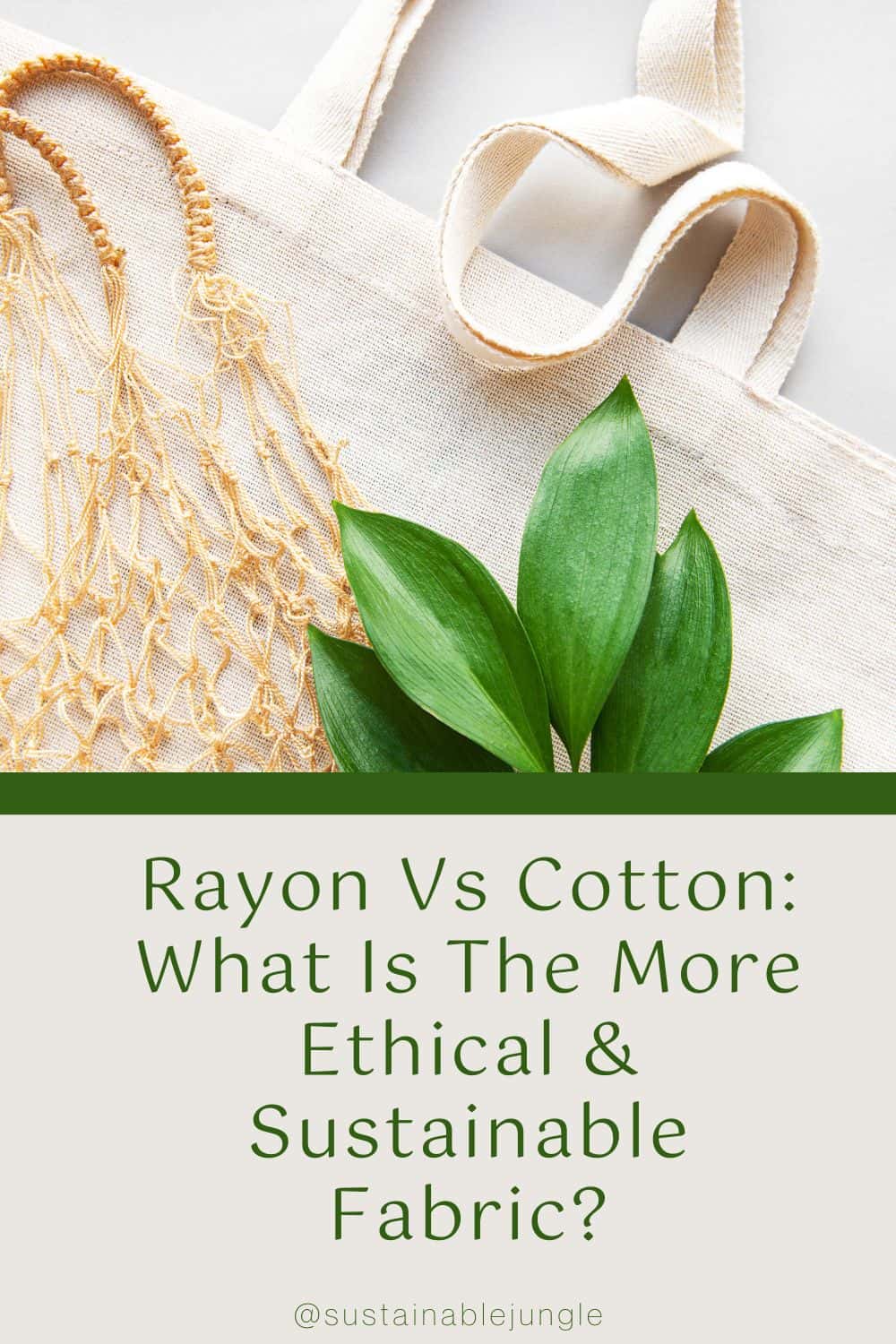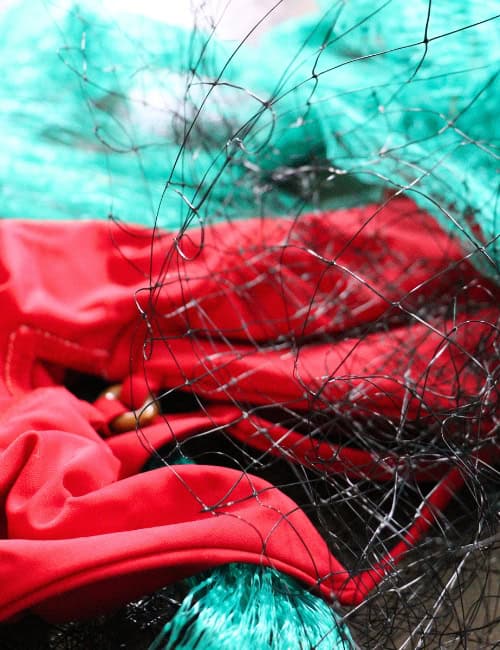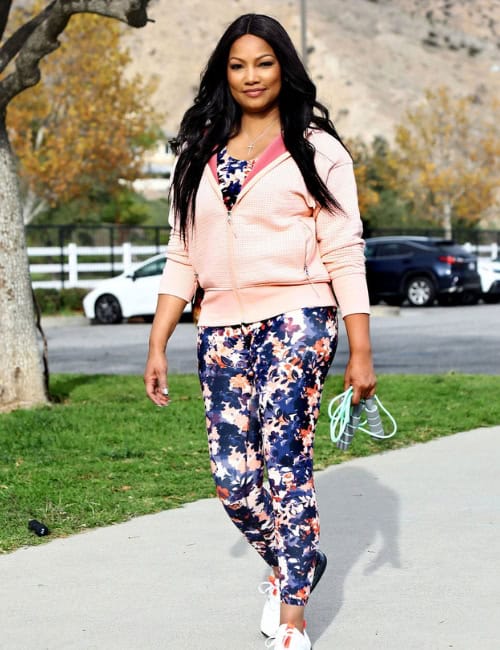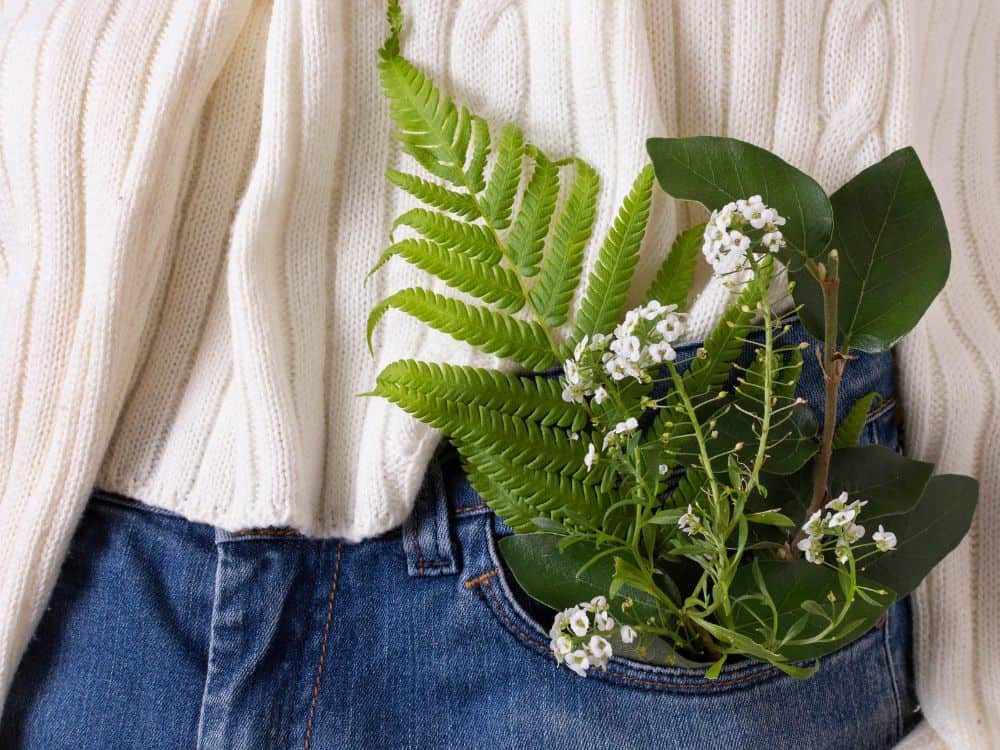
Rayon Vs Cotton: What Is The More Ethical & Sustainable Fabric?
In our quest to shed a ray of light on the often unsustainable textile industry, we investigated rayon fabric only to find a fray in the notion that it’s an eco friendly fabric.
Rayon is a plant-based fiber, but it undergoes a significant chemical-laden process to render it into a usable semi-synthetic fiber.
But how does it compare to some of our other most used fabrics?
Specifically, we’re talking about rayon vs cotton.
Cotton is also a plant-based fiber, and its final product remains a natural fiber. So it must be lush for our bodies and the environment, right?
Not exactly. Many chemicals also contribute to the world’s “dirtiest” natural fabric.
In other words, cotton and rayon aren’t the world’s most eco-friendly fabrics by a long way.
To get the full scope of the cotton vs rayon debate, let’s break down these technically-biodegradable fabrics one stitch at a time.
1. What is Rayon Fabric?
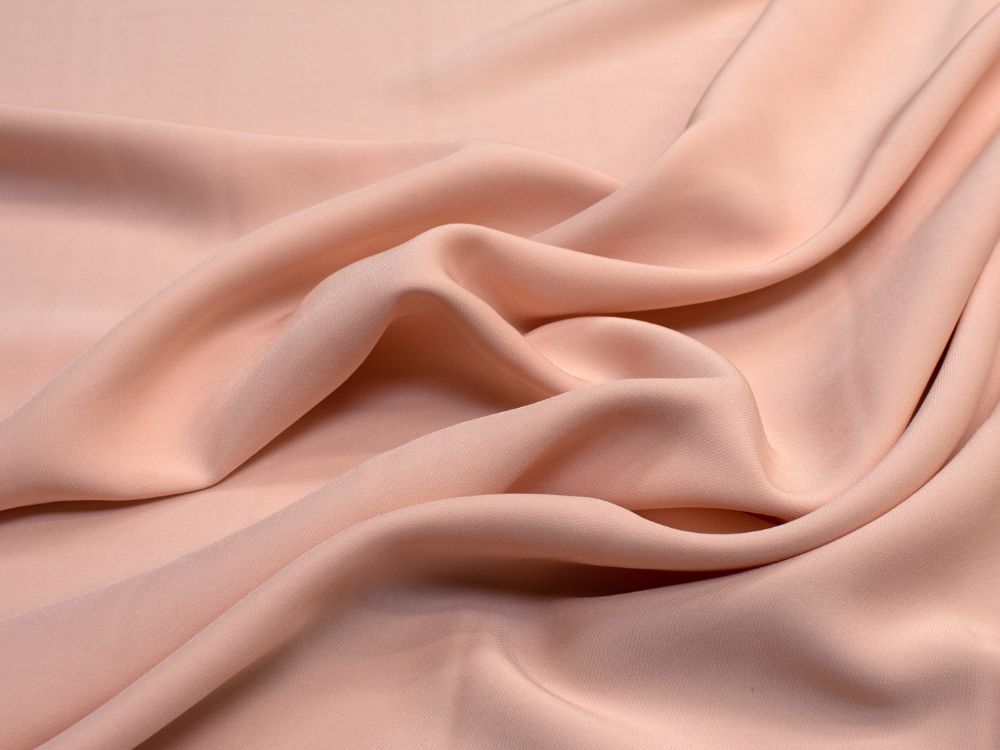
Rayon, sometimes called viscose or viscose rayon, was first invented in the 1800s by accident. Chemists were looking to create explosives, but instead ended up with what became one of the world’s foremost semi-synthetic fabrics, or “cellulosic fibers”.
The invention “exploded” onto the market as a more affordable and artificial silk alternative.
Rayon most commonly comes from the processed pure cellulose (AKA wood pulp) of bamboo, pine, eucalyptus, or beech trees. While it begins as a natural material, an intense chemical process occurs to transform the wood pulp into rayon fibers.
Rayon is also known as viscose or viscose rayon, and sometimes lyocell fabric and modal fabric—though these semi-synthetic fabrics are typically not lumped in with viscose rayon for their more sustainable production methods.
Bamboo rayon, cactus leather, banana “silk” fabric, seaweed fabric, and all other human-created plant-based fibers are likewise technically part of the rayon fabric family.
When brands market an innovative new “natural” fiber, especially in sustainable activewear and sustainable outdoor clothing, it is most likely some type of rayon.
As a rule of thumb, unless a company is open about what chemicals and (ideally closed-loop) processes they use to make their “regenerative” or “plant-based” fabrics, it’s safest to assume there’s some greenwashing going on.
What Are the Different Kinds of Rayon?
There are many different types of rayon, some better than others:.
- Viscose is famous for its silk-like texture. While viscose rayon drapes nicely and is generally durable and absorbent, it also has low “wet strength,” which means it can stretch or shrink easily if wet.
Oftentimes viscose garments need dry cleaning, which is a whole other eco headache.
- Modal is the softest and most comfortable type of rayon. It begins its life as beech-tree pulp and makes a stretchy, soft fabric.
- Lyocell has a very similar look and feel to modal, but is made using eucalyptus pulp in a less chemical-laden process.
Both lyocell and modal are largely created by Austrian company Lenzing under the name TENCEL™.
Third-party verified for their use of sustainable sourcing and closed-loop manufacturing (i.e. recycling all solvents and water used to process the pulp), TENCEL™ is the most widely utilized maker of these fabrics.
For that reason, both lyocell and modal have come to be regarded as something separate from standard rayon. Unlike with bamboo rayon or viscose rayon, “rayon” is never attached to the terms lyocell and modal.
How Is Rayon Created?
Herein lies the heart of the (plant) matter.
While called a “semi-synthetic”, this is misleading, because there isn’t much natural about the way in which rayon—especially viscose rayon—is created.
It begins by steeping wood pulp in a caustic soda solution of sodium hydroxide. After days of chemical aging, the crumbs are mixed with carbon disulfide, which are dissolved again in sodium hydroxide to form a honey-colored viscous (hence the name).
After aging and oxygen removal, it’s extruded through a spinneret to create fibers, which are placed in an acid bath of sulfuric acid, sodium sulfate, glucose, and zinc sulfate. Here the solution is regenerated (hence the common greenwashed marketing ploy) back into cellulose fiber, or rather, viscose rayon.
That isn’t so eco friendly sounding, is it?
2. Is Rayon Sustainable & Ethical?
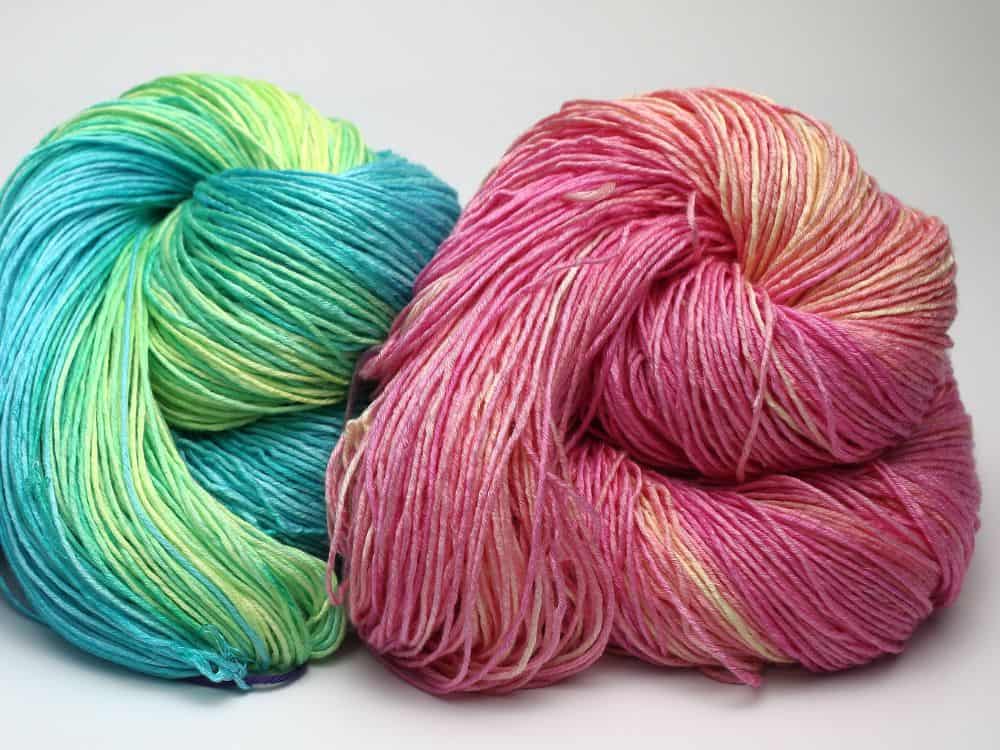
Is Rayon Ethical?
We’ve detailed the chemical processes that produce rayon fibers—but who performs those processes?
That’s right, human factory workers bear the brunt of rayon’s less than healthy processing.
Since rayon’s invention 150 years ago, the same chemicals have been used to make it, despite many studies showing the negative impact they have on humans.
In fact, creating viscose rayon is so harmful that much of its creation process is now banned in the United States.
Meanwhile, rayon is the most popular man-made cellulosic fiber, with approximately 79% market share and 5.3 million tons produced in 2018.
This means that textile garment workers in countries like Bangladesh, China, India, and Indonesia must work with dangerous chemicals to produce viscose rayon.
Firstly, the caustic soda used is corrosive and can cause blindness.
Secondly, sulfuric acid is battery acid. It’s a classified hazardous substance and causes significant burn damage to skin and eyes. When inhaled as a mist, the National Institute of Health classifies it as a human carcinogen.
Thirdly, and the most concerning of all, is the use of carbon disulfide (CS2).
This can cause a toxic degenerative brain disease with adverse effects on the nervous system, including personality changes, dizziness, anxiety, anorexia, vision changes, and Parkinsonian paralysis.
Beyond the brain and nervous systems, it can also inflict acute complications upon the kidneys, heart, nerves, liver, eyes, blood, and skin.
CS2can even cause mental deterioration and psychosis amongst garment workers who are exposed long term.
In a 1983 study, almost half the workers were poisoned after just one year of working with the substance.
In short, the ethical conundrum of viscose rayon production is as harsh as the chemicals it involves.
Is Rayon Sustainable?
The environmental impact of carbon disulfide used to create rayon is as alarming as its human impact.
For every gram of viscose rayon produced, up to 30 grams of CS2 is released into the environment, making its way into drinking water, animals, and humans.
Then there’s the impact of deforestation to make rayon—over 150 million trees per year. If placed end to end, those trees would circle the earth seven times.
Worse, between 2013 and 2020, the number of trees logged for viscose rayon doubled.
Logging for fast fashion has reached a tipping point, with less than 20% of the world’s old growth forests remaining. The implications for indigenous communities, biodiversity, food security, and the environment are of top concern.
Lastly, traditional rayon production requires huge amounts of toxins, water, and energy. Unless we’re talking TENCEL™, it’s also not closed-loop or circular.
It requires high-impact cleaning like dry cleaning and doesn’t always biodegrade. When it does, it’s filled with chemicals we don’t want in our soils.
Sustainable Forms Of Rayon Fabric
Once again Lenzing’s TENCEL™ modal and lyocell are two big exceptions.
The main difference between the two is that lyocell is made through a more sustainable solvent spinning technique that causes no significant chemical change to the fibers.
Lenzing isn’t the exclusive modal and lyocell producer, but they’re seen as the most sustainable.
Aside from recapturing inputs via a closed-loop system, these fabrics are stronger, more absorbent, and more durable, capable of being loved for years to avoid the local landfill.
Other healthier alternatives to conventional rayon include:
- Refibra™
- Re:newcell
- EvrnuFiber™
- Orange Fibre
- Birla Eco Viscose
Now onto our next ethical fuzzy fabric…
3. What is Cotton?
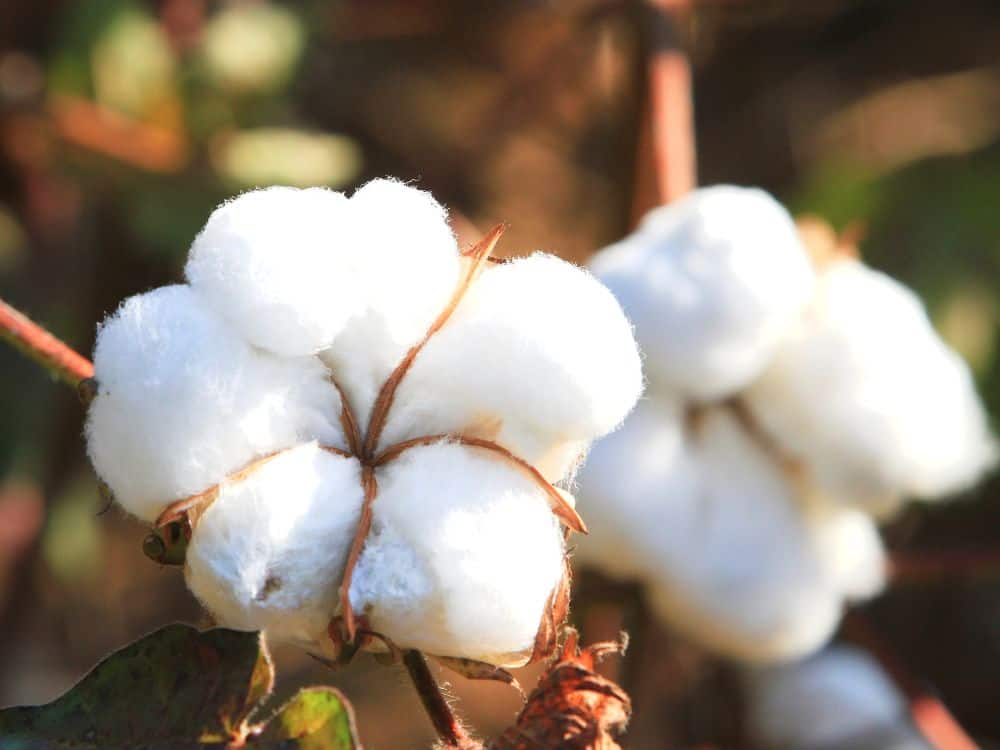
Cotton originates from the wooly tissues grown within cotton bolls on the cotton plant. These small, dense, fluffy “clouds” of natural fiber get spun into cotton thread, which can be woven into anything from cotton socks to organic cotton pajamas.
Cotton has a long and complicated history. Originally developed and grown in India, its balance of strength and softness made it popular fast during the Industrial Revolution, especially in Britain and the US.
Most nefariously, the demand for cotton was the main impetus for enslaving people in both the US and many British-governed areas of the world at the time.
How is Cotton Created?
Cotton is a natural fiber but its process to satisfy fast fashion demands of the textile industry is not.
Cotton plants are grown en masse, and either a cotton picker machine or a cotton stripper machine remove the cotton bolls. Generally a stripper is more invasive, as it destroys the whole cotton plant after a single harvest and wastes a lot of the plant.
Alternatively, cotton is picked by hand, but up to 20% of hand picked cotton in China is reportedly done via forced labor.
The natural fibers are then cleaned of its seeds and debris, after which it is turned into spools of cotton yarn. This happens at spinning mills.
From the yarn form, cotton fabric is made by weaving it with a loom—into everything from jersey knit for t-shirts to denim to the sateen bed sheets.
What Are the Different Kinds of Cotton?
There is no “perfect” fabric out there (yet!). Cotton is no exception, but there are some more sustainable versions of it.
There are six common types of cotton fabric:
- Pima Cotton: Grown in South America, these long-staple fibers yield the highest quality and softest cotton that exists.
- Egyptian Cotton: The same species as Pima, but grown in Egypt and using uniquely Egyptian methods.
- Upland Cotton: Classic, cheap, GMO cotton contributing to the devastating effects of arid land, chemical runoff, monoculture, and forced labor.
- Organic Cotton: Non-GMO cotton plants are grown pesticide-free, though (especially given greenwashing surrounding organic cotton) it doesn’t always guarantee a smaller carbon footprint.
- Regenerated Cotton: Recycled, regenerated, or upcycled cotton is more environmentally friendly than organic cotton and performs just as well.
Regenerative Cotton: Takes organic methods a step further, by making the farming process biodynamic, holistic, zero-waste, and closed-loop.
4. Is Cotton Sustainable & Ethical?
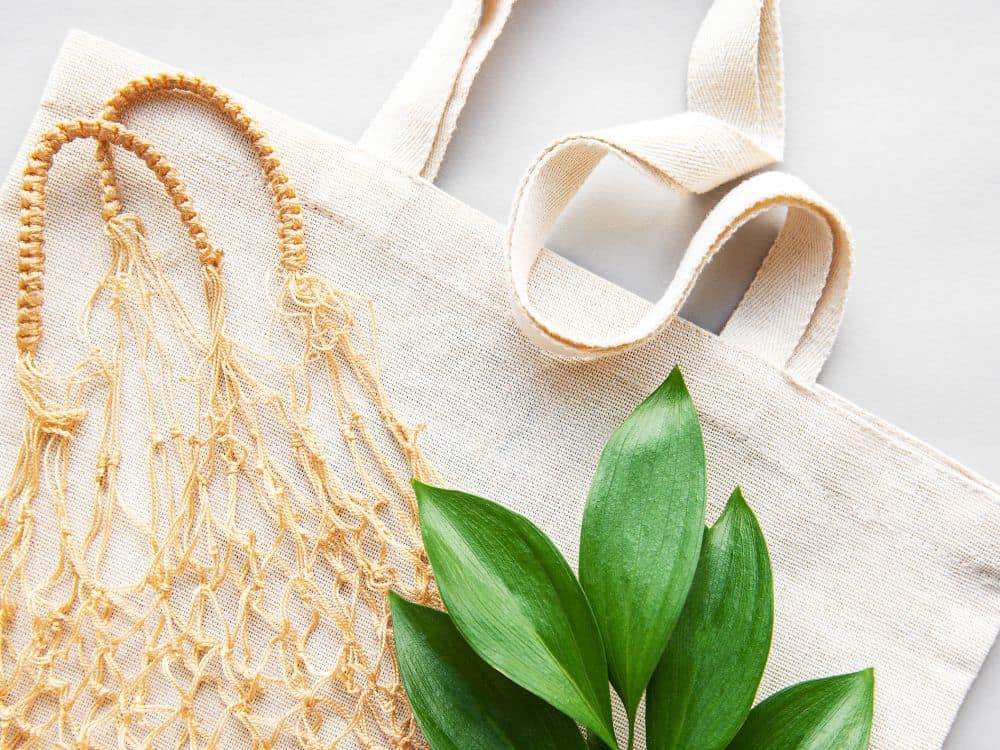
Compared to rayon, cotton is stronger, more breathable, less flammable, retains color better, and is more natural—but does that mean it’s “better”?
Not necessarily.
Is Cotton Ethical?
Despite advances in technology, modern cotton production is hardly more ethical than it was in the times of US slavery.
In the words of renowned activist Vandana Shiva, “Cotton has become a seed of slavery.”
All too often, profits over people create an unethical cotton harvesting and production model, one where government subsidies go to industrial farms instead of hungry small-scale farmers forced to rely on volatile cotton market prices.
In India, cotton farmers are paid so little, they choose “death over distress”, resulting in one farmer suicide every eight hours.
Then there is the aforementioned forced labor crisis with cotton in places like China and Turkey—the latter of which provides 83 fashion brands (including H&M and Zara) with cotton through slave labor.
All in all, the only current cotton types considered ethical are recycled, fair trade, and organic cotton—though testimonies regarding the falsification of “organic” farming methods in India and China especially call the ethics of organic cotton into question, too.
Is Cotton Sustainable?
The not-so-soft reality is that conventional cotton cultivation interconnects many environmental, social, and economic issues and is not sustainable.
Especially because it’s a thirsty crop grown in semi-arid places, where water scarcity is often a serious issue. It takes 2700 liters of water for just one t-shirt!
Copious amounts of damaging chemicals help grow the crop, hence its infamous tag as the world’s “dirtiest crop”.
While organic cotton farming (less than 1% of all cotton and dwindling) seeks to solve these problems, organic certifications are not a guarantee because of the exploitation of loopholes that have allowed falsified documents. Even being GOTS-certified organic does not mean it actually is.
Organic cotton also leads to resource issues. Since it’s a rare commodity, the overall lower yield can result in more land, water, and energy to produce the same amount of cotton, as well as higher greenhouse gas emissions.
While not organic, the Better Cotton Initiative supposedly seeks to help bridge the sustainable gap between the two by making improvements, but BCI cotton, too, has come under fire for paying more lip service to consumers than anything else.
The most sustainable type of cotton is recycled cotton, which receives an “A” rating from Made-By.
It’s made from post-industrial and post-consumer waste and production uses less water and energy compared with organic cotton.
Lastly, if cotton is “regenerative”, it means it is bio-dynamic and fosters an entire natural ecosystem.
When cotton is regenerative or organic, it also means it can biodegrade safely. The same doesn’t hold for recycled cotton as it may have been made with toxic chemicals during its first life.
5. Rayon Vs Cotton Fabric Performance
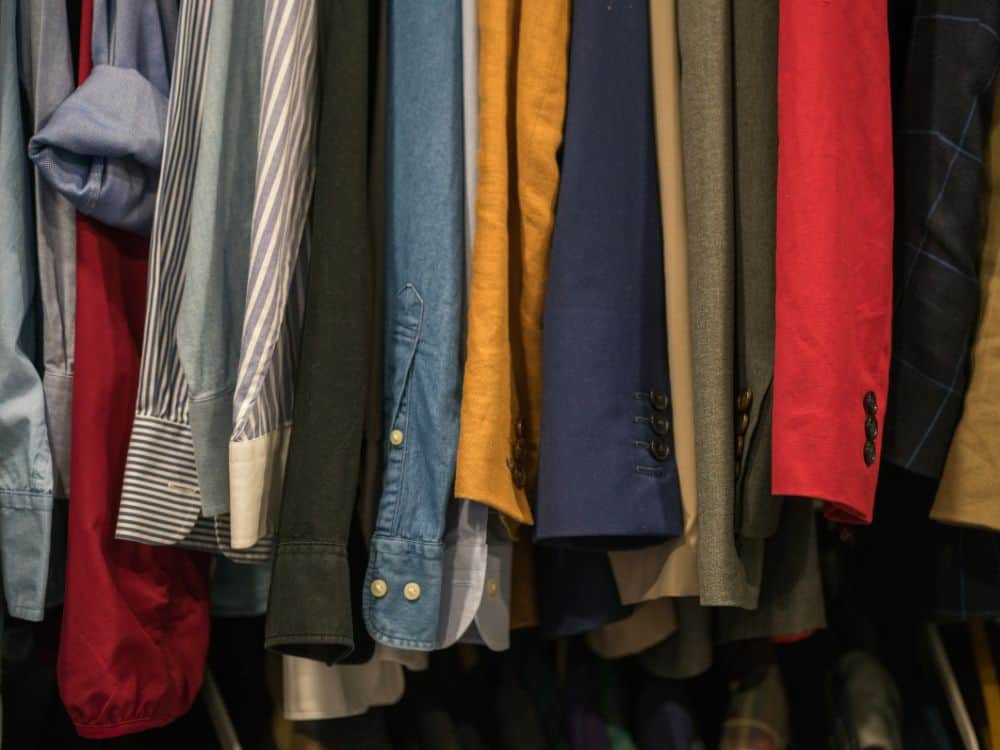
| Attributes | Rayon | Cotton |
| Origin | Cellulose fiber that’s chemically processed | Cotton Plants |
| Strength / Durability / Longevity | Weak when wet / lasts many years with proper care | Strong / durable / stretches over time |
| Pilling | No pilling | Pills over time |
| Breathability | Some varieties are breathable fabric | The most breathable fabric |
| Absorbency | More absorbent than cotton, but can stretch when wet | Very absorbent, yet does not dry quickly |
| Comfort / Softness | More soft than many synthetic fabrics | One of the softest there is |
| Cost | More expensive than other synthetic fabrics, but cheaper than silk | More expensive than synthetic fabrics, especially organic cotton |
| Care | Often needs drycleaning | Easy care |
| Uses | Lightweight clothing for hot weather, fitness and outdoor wear, some bedding | Everything made of fabric can use cotton, from clothing to bedding to medical equipment |
| Sustainability / Innovation | Renewable plant resource but not an eco-friendly or socially responsible production. Look to Tencel as an example of more sustainable innovation. | Production needs lots of harmful chemicals, but is more eco-friendly than most synthetic fabrics. Look to organic, regenerative, or recycled cotton for innovation. |
When it comes to choosing between cotton sheets and bamboo rayon sheets, you may find yourself asking about the characteristics of the fabrics themselves.
Is rayon like cotton? And if so, in what ways?
Is rayon more comfortable than cotton?
Let’s start with the principal factor which most of us consider when choosing our clothing: comfort. Is rayon more comfortable than cotton?
It depends on how you define comfort.
Today, there are many different textures of rayon fabric, the most popular being artificial silk.
Going back to the bed sheets example, if you prefer something soft and silky, there’s no question about what wins the rayon vs cotton sheets debate.
However, cotton fibers can also be woven in a variety of textures, including cozy comforts like faux-fleece and brushed microfiber.
Is rayon cooler than cotton?
Rayon vs cotton’s breathability is a close call, rayon is fairly breathable like cotton (if only a little less so) but it’s better at temperature regulation.
So is rayon better than cotton in summer?
While rayon is marginally more cooling, both are lightweight and breathable enough to keep you cool in the summer heat.
However, if you were to compare rayon vs cotton’s moisture absorbency, you’d find rayon is moisture-wicking and quick-drying, while cotton simply absorbs moisture and stays wet. So if summertime means sweat for you, a cotton shirt may not be your ideal choice.
It also means that garments worn specifically in high-moisture areas (rayon vs cotton socks, anyone?) can better benefit from the semi-synthetic fiber.
Is rayon more expensive than cotton?
Because it requires less land, inputs, and effort to create, viscose rayon is usually cheaper than cotton, and certainly cheaper than organic cotton.
But remember that price and sustainability are often inversely correlated, so those rayon threads you find in your mall’s fast fashion outlet may have price tags seemingly too good to pass up, but ask yourself why that is.
For that reason, lyocell and modal often cost far more than cotton.
What about a cotton rayon fabric blend?
It’s not unusual to find a rayon and cotton blend to capture the benefits of both fabrics. The result is a fabric that drapes better than cotton, doesn’t wrinkle, is durable, and feels softer.
Rayon cotton also combines rayon’s stretchiness with cotton’s enhanced breathability.
6. Rayon Vs Cotton Sustainability
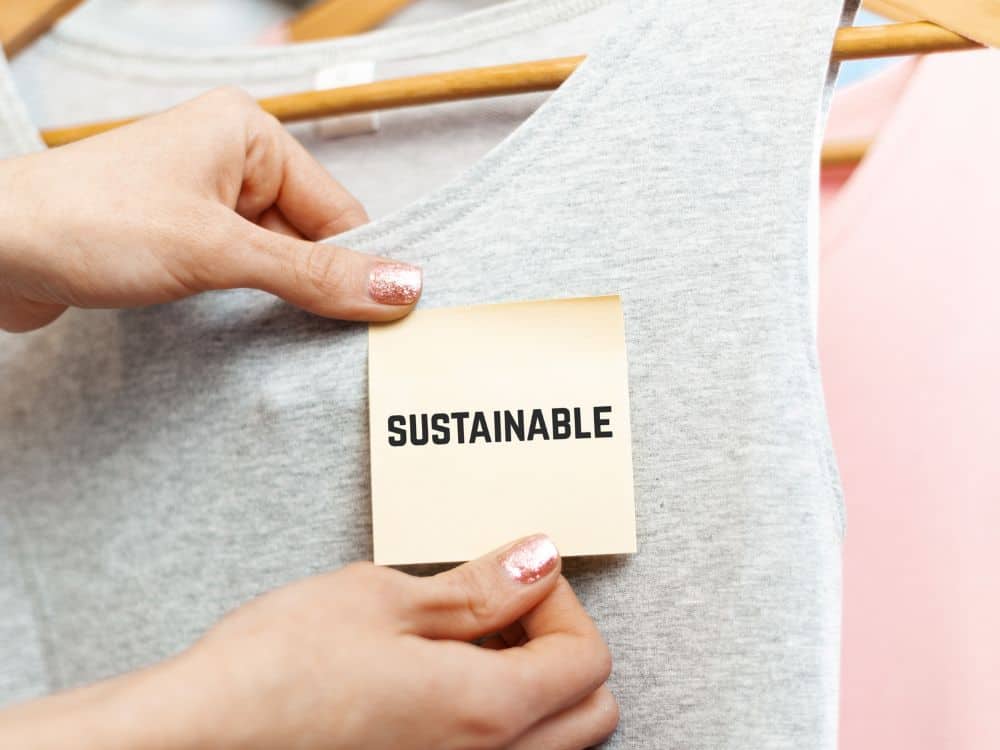
So is rayon more sustainable than cotton? Or vice versa?
Really, the answer is either or neither. Clear as cotton seeds?
They both begin life as natural fibers and both are associated with heavy chemical use.
Cotton and rayon fabrics have their own pros and cons, and it depends on what kind of rayon and cotton we’re talking about.
- Viscose rayon vs cotton: The Higg Materials Sustainability Index ranks rayon as more sustainable than conventional cotton.
- Rayon vs organic cotton: Higg also ranks rayon as less sustainable than recycled, regenerative, or organic cotton.
- Rayon vs cotton vs modal & lyocell: Sustainably-made modal and lyocell top both rayon and conventional cotton (and perhaps even organic considering the recent questions surrounding it). Especially if you opt for something made from TENCEL™ clothing brands.
- Bamboo rayon vs cotton: Bamboo rayon can also be produced in a closed-loop manner but because there is no one reputable maker of bamboo rayon, it’s harder to tell whether “sustainable bamboo” claims are legit or as green(washed) as the bamboo itself.
Rayon vs Cotton Durability
Durability is another huge factor of sustainability because it dictates how long something is capable of lasting.
Cotton and rayon both are durable fabrics.
But if you’re diligent about caring for rayon, your cotton shirt will probably stretch and fade far faster.
Both cotton and rayon shrink if not washed properly in cold water and hung to dry (the most sustainable laundering method anyway).
7. Cotton Vs Rayon Vs Other Fabrics
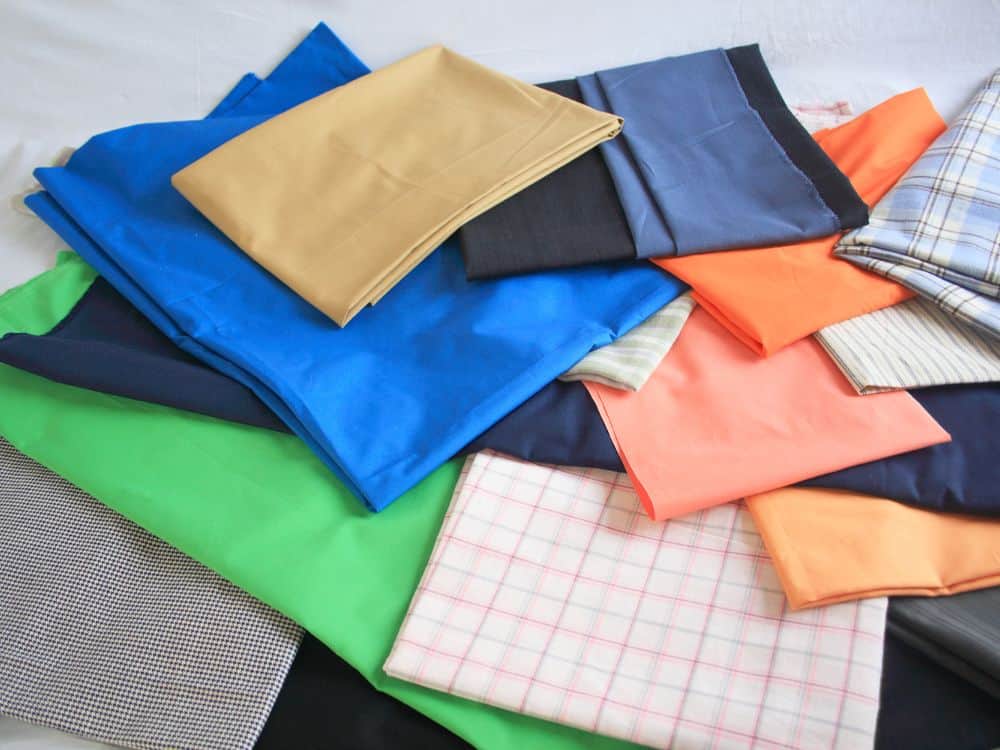
While there is no definitive answer as to whether rayon or cotton is more sustainable, we can say with certainty that both are better than synthetic fabrics.
Even when cotton is at its dirtiest, it’s still not as dirty as the petroleum-based resources needed to produce any plastic-derived synthetics like nylon and polyester.
If you’re comparing rayon vs polyester vs cotton, polyester should be your last choice—unless it’s recycled and makes use of fabrics or plastic bottles already in existence. In which case, finding the better choice goes back to what type of rayon and cotton you’re using as a comparison.
Did you know we Have a Newsletter?
We cover the latest in sustainable living, fashion, zero waste, beauty, travel, finance and more…
Final Thoughts on Rayon Fabric vs Cotton
It goes without saying, but the most sustainable option is the garments already hanging in your closet.
150 billion new clothing items are currently created globally each year—and 17 million tons are discarded in that same timeframe.
As far as rayon fabric vs cotton, there is no quick fix for what fabric conclusively has the least negative impact. It all depends.
Our advice?
The next time you find yourself in need of some new apparel, take the time to read the label. Opt for organic cotton fibers and closed-loop manufactured rayon which will ultimately contribute towards a healthier planet for us all.
If we’ve inspired you to inspire others to do their cotton vs rayon homework, please go (ray)on and share this article.
Pin these:
